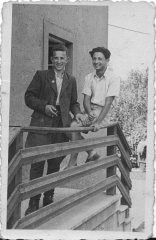You searched for: 海外商城系统源码快速搭建【TG���������@EK7676】平台包网搭建海外商城系统源码快速搭建【TG���������@EK7676】平台包网搭建19Ez42Yfxf
<< Previous | Displaying results 26-50 of 177 for "海外商城系统源码快速搭建【TG���������@EK7676】平台包网搭建海外商城系统源码快速搭建【TG���������@EK7676】平台包网搭建19Ez42Yfxf" | Next >>
-
Judith Gabriel Dichter: Maps
Media EssayJudith Gabriel Dichter was living in Vienna when Germany annexed Austria in 1938. A Jew, she was later deported to the Theresienstadt ghetto in Czechoslovakia. On September 19, 1942, she was deported to Maly Trostin...
-
SS and Police Leader Juergen Stroop interrogates two captured Jews
PhotoSS and Police Leader Juergen Stroop interrogates two Jews arrested during the Warsaw ghetto uprising. Poland, April 19-May 16, 1943.
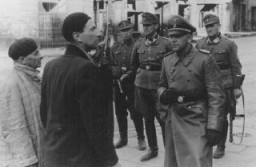
-
Forcing Jews out of hiding during the Warsaw ghetto uprising
PhotoJewish homes in flames after the Nazis set residential buildings on fire in an effort to force Jews out of hiding during the Warsaw ghetto uprising. Poland, April 19–May 16, 1943.
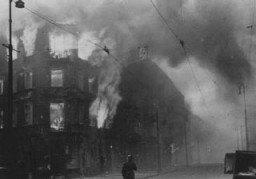
-
Hannah Szenes
PhotoHannah Szenes on her first day in Palestine. Haifa, Palestine, September 19, 1939. Between 1943 and 1945, a group of Jewish men and women from Palestine who had volunteered to join the British army parachuted into German-occupied Europe. Their mission was to organize resistance to the Germans and aid in the rescue of Allied personnel. Hannah Szenes was among these volunteers. Szenes was captured in German-occupied Hungary and executed in Budapest on November 7, 1944, at the age of 23.
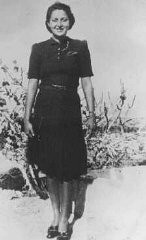
-
Jewish refugees on the Exodus 1947 ship
PhotoBritish police stand among Jewish refugees on the decks of the refugee ship Exodus 1947 at Haifa port. British forces returned the refugees to displaced persons camps in Germany, dramatizing the plight of Holocaust survivors attempting to enter Palestine. July 19, 1947.
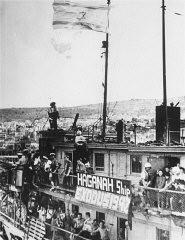
-
Passengers on board the Exodus 1947
PhotoPassengers on board the Exodus 1947 refugee ship, which has just arrived at the Haifa port, peer out of cabin windows. The British forcibly returned the refugees to Europe. Haifa, Palestine, July 19, 1947.
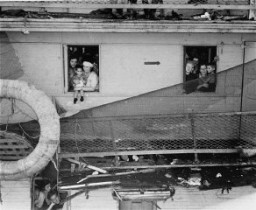
-
A refugee collapses
PhotoAn exhausted Jewish woman from the Exodus 1947 refugee ship is given a drink as British soldiers stand nearby. The British forcibly returned the passengers to Europe. Haifa, Palestine, July 19, 1947.
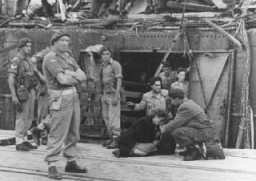
-
Jews captured during the Warsaw ghetto uprising
PhotoSS personnel capture two Jewish resistance fighters who were pulled from a bunker during the suppression of the Warsaw ghetto uprising. Warsaw, Poland, April 19-May 16, 1943.
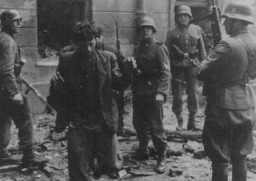
-
Jews captured during the Warsaw ghetto uprising
PhotoMembers of the Jewish resistance are captured by SS troops on Nowolipie Street during the suppression of the Warsaw ghetto uprising. Warsaw, Poland, April 19-May 16, 1943.
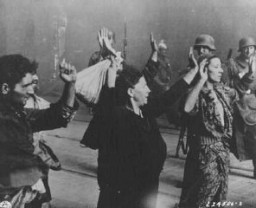
-
Adolf Hitler leaves the Reich Chancellery after meeting with President Paul von Hindenburg
PhotoA crowd of saluting Germans surrounds Adolf Hitler's car as he leaves the Reich Chancellery following a meeting with President Paul von Hindenburg. Berlin, Germany, November 19, 1932.
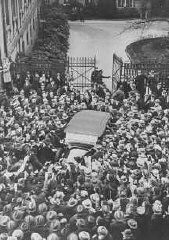
-
Elie Wiesel with his wife and son during the Faith in Humankind conference
PhotoElie Wiesel (right) with his wife and son during the Faith in Humankind conference, held several years before the opening of the United States Holocaust Memorial Museum. September 18–19, 1984, in Washington, DC.
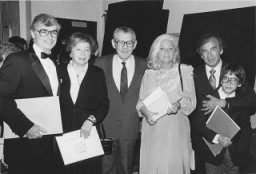
-
Captured Jewish resistance fighters in Warsaw
PhotoJewish resistance fighters who were captured by SS troops during the Warsaw ghetto uprising. Warsaw, Poland, April 19-May 16, 1943. The original German caption reads: "These bandits offered armed resistance."
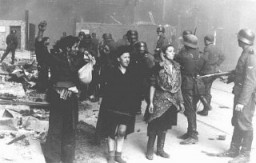
-
Janowska
ArticleIn 1941, the Nazis established Janowska camp. It was primarily used as a forced-labor and transit camp.
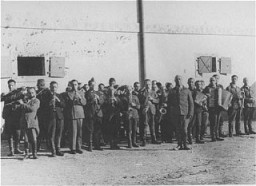
-
Helen Keller
ArticleHelen Keller was an author, suffragist, and disability rights advocate. Her socialist and anti-war writing was burned under the Nazi regime in 1933. Learn more.
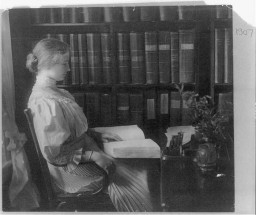
-
Eschwege Displaced Persons Camp
ArticleAfter WWII, many Holocaust survivors, unable to return to their homes, lived in displaced persons camps in Germany, Austria, and Italy. Read about Eschwege DP camp.
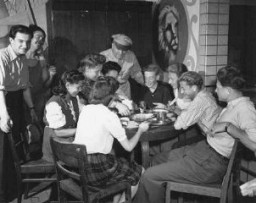
-
Underground bunker in Warsaw
PhotoAn underground bunker, built by Jews in Warsaw in preparation for anti-Nazi resistance. This photograph shows cooking facilities in a bunker. Jews hid in bunkers while the Germans systematically destroyed the ghetto during the uprising. Warsaw, Poland, April 19–May 16, 1943.
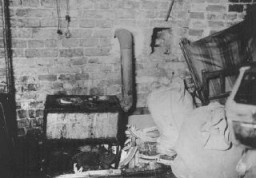
-
Aron and Lisa Derman: Oral History Excerpts
Media EssayIn 1942, Aron Derman and Lisa Nussbaum escaped deportation from the Grodno ghetto with the help of Tadek Soroka, a non-Jewish Pole. Aron and Lisa—aged 19 and 15—joined the armed Jewish resistance. As partisans, they f...
-
Captured Jews during the Warsaw ghetto uprising
PhotoGerman soldiers arrest Jews during the Warsaw ghetto uprising. Poland, May 1943. The Warsaw ghetto uprising began on April 19, 1943, after German troops and police entered the ghetto to deport its surviving inhabitants. By May 16, 1943, the Germans had crushed the uprising, deported surviving ghetto residents, and left the ghetto area in ruins.
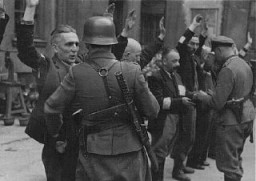
-
A US soldier stands among the corpses of prisoners exhumed from a mass grave near Nammering
PhotoA US soldier stands among the corpses of prisoners exhumed from a mass grave in a ravine near Nammering. On April 19, 1945, a freight train with nearly 4,500 prisoners from Buchenwald pulled onto the railroad siding at Nammering. Hundreds of prisoners who had died on the train were buried in the mass grave along with the prisoners who were forced to carry the corpses to the ravine and were then shot. Germany, ca. May 6, 1945.
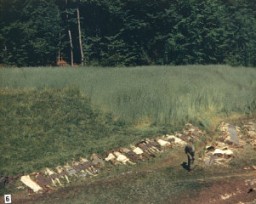
-
Photograph taken at Esther Salsitz's marriage
PhotoPhotograph taken at the marriage of Esther Salsitz and her fiance. Esther's parents, Norman and Amalie, stand at left and right (respectively). June 19, 1977. With the end of World War II and collapse of the Nazi regime, survivors of the Holocaust faced the daunting task of rebuilding their lives. With little in the way of financial resources and few, if any, surviving family members, most eventually emigrated from Europe to start their lives again. Between 1945 and 1952, more than 80,000 Holocaust…
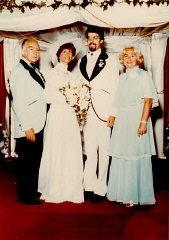
-
The Holocaust in Subcarpathian Rus and Southern Slovakia
ArticleLearn more about the history of the Transcarpathian region of Ukraine (historically known as Subcarpathian Rus) during World War II.
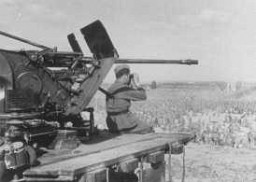
-
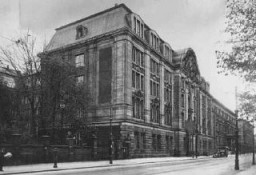
-
Subsequent Nuremberg Proceedings, Case #5: The Flick Case
ArticleThe Flick Case was Case #5 of 12 Subsequent Nuremberg Proceedings against leading German industrialists, military figures, SS perpetrators, and others.
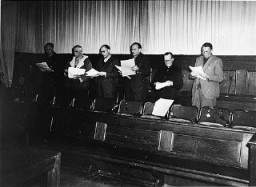
-
Subsequent Nuremberg Proceedings, Case #7, The Hostage Case
ArticleThe Hostage Case was Case #7 of 12 Subsequent Nuremberg Proceedings against leading German industrialists, military figures, SS perpetrators, and others.
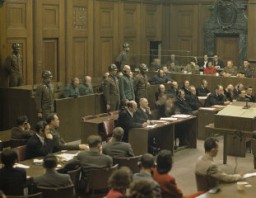
-
Leon Senders
ArticleRead the Jewish Partisan Educational Foundation's short biography of Leon Senders.
